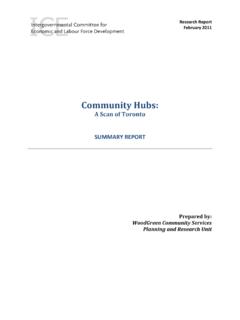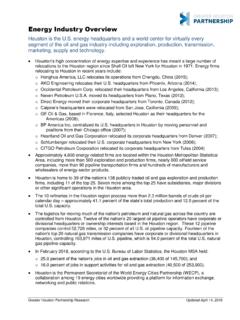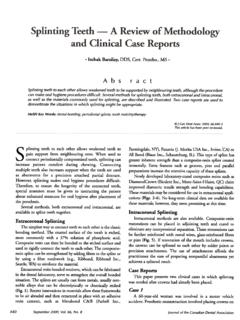Transcription of Exercise Guidelines for Clients with Lymphedema
1 Exercise Guidelines forClients with LymphedemaInformation for Personal TrainersLymphedema is the swelling of the arm, leg, trunk, abdomen, neck or face due to an abnormalaccumulation of fluid in the tissues as a result of damage to or removal of part of the lymph vesselsystem. People who have had cancer treatment including the removal of lymph nodes and/orradiation are at risk of developing Lymphedema any time after their treatment. Other causes aresurgery, infections, traumas as well as congenital malformation of the lymph vessel system is responsible for returning fluid from the tissues to the heart. It brings back10% of the fluid sent to the tissues by the arterial system. Therefore anything that increases arterialflow such as heat and Exercise can put a greater load on the lymph vessel system which may worsenlymphedema.
2 However Exercise can also have benefits to improve oxygen delivery to the cells andimproved cardiovascular fitness. Therefore, finding the balance between enough Exercise and toomuch Exercise is especially important for Clients who have on breast cancer survivors who participate in dragon boat racing has shown that anexercise program including flexibility, resistance training and cardio done on a regular basis allowswomen to participate in such sports with no detrimental effects to their risk of Lymphedema or statusof Lymphedema . Most of these studies recommend that the participants wear compression garmentswhile exercising and rowing. These garments are discussed on page TrainingWith respect to resistance training, starting at very low weights or resistance and increasing verygradually can be helpful.
3 If any signs of onset or worsening of Lymphedema (see page 2) are noticed,then the number of reps or the amount of resistance can be reduced to a symptomless level for aweek or so. The goal is to slowly increase strength without causing more Lymphedema addition to this, interval training in which arms and legs are alternated can be helpful as well. Thisgives the lymph vessel system in the upper extremities or the lower extremities time to catch up withthe increased demand while another area is worked. If the demand for fluid return exceeds thecapacity of the system, swelling will exercises are important since the lymph vessel system will function less effectively throughtight tissues. However these exercises should be done so that the client can feel a gentle tug on thetissues.
4 Pushing or bouncing until tissues tear (even micro-tears) will cause an inflammatoryresponse which increases the fluid in the affected area and may overload the lymph vessel pain, no gain is not helpful for those with Lymphedema or at risk for Lymphedema . Clinically wehave seen some Clients who go to a gym, overdo it, get an increase in swelling and never return tothe gym. It is better to help Clients be successful in the long term with a slow, gentle GarmentsClients with Lymphedema or at risk for Lymphedema may be wearing a compression garment whileexercising that has been recommended by their health care professional. This may include a sleeve,glove or gauntlet or stocking. The purpose of the garment is to increase the pressure on the interstitialfluid in the affected tissues thus helping the fluid to return to the heart via the lymph vessel systemand the veins.
5 Physiologically, Exercise increases the flow of blood to the tissues which decreases blood pressurein the vessels. The tissues may retain this increased fluid for many hours after Exercise has compression sleeve therefore helps the affected body part to return this extra fluid and not let itget left behind in the tissues. Clients should be advised to wear the sleeve (many will have asecond one to replace the sweaty Exercise garment) even after exercising for a number of of Heat and IceSince heat increases blood flow to the skin, it therefore increases the load on the lymph vessel. Forthis reason, saunas, hot tubs and other sources of higher heat are not helpful for those withlymphedema. Exercise produces it s own heat which has to be taken into overall consideration aswell.
6 Heat shouldn t be used to help sore muscles in the affected areas of the body. Ice if usedshould only be used for 5 minutes at a time as it also increases blood flow after 7 minutes of Onset of Lymphedema Initially, symptoms can come and go. So if there is more swelling after Exercise but it goes awayover night, this could be the beginning of Lymphedema and the Exercise program should bereduced for a week or so. An increase in size of the limb as compared to the other side (therefore increase is not due toincreased muscle) A feeling of heaviness, fullness, tightness or bursting sensation in the limb Puffiness, pins and needles sensation Aching limb or aching in back of the shoulder which doesn t feel like muscle soreness Any swelling or heat in the chest on the same side as the surgery (for breast cancer treatment)
7 After abdominal surgery, tenderness in groin or bloating of abdomen Jewelry or clothing feeling tighter Decreased mobility in wrist or ankle due to swellingSigns of Worsening Lymphedema Any of the previous signs for the onset of Lymphedema A compression garment gets too tight or feels tighter than usual Pins and needles in the fingers and toes which is new Lack of feeling in any area of a limb which is new Skin thickening or rough areas Leaking areas on the skin (clear fluid) start to occur Red patches may indicate an infection client should see a physician immediatelyResourcesNational Lymphedema Network (San Francisco, CA) website has good free information onlymphedema and resources which can be purchased. ,S. & McFarland, J. (2005). Exercising with Lymphedema is a balancing act.
8 LymphovenousNews, 8(3).Pr;intout available from Toronto Lymphocare Centre website: more information contact:Toronto Lymphocare Centre244 Dupont St., Toronto, ON M5R 1V7(416) 531-7612






